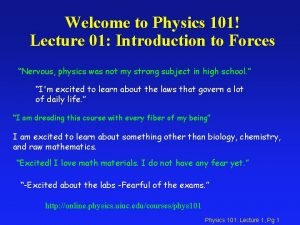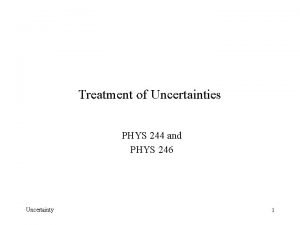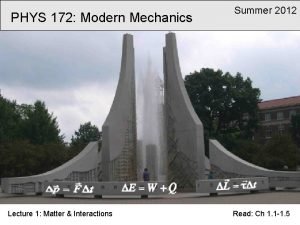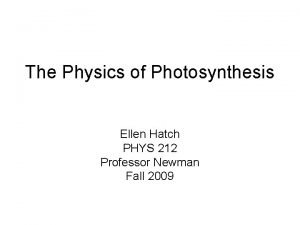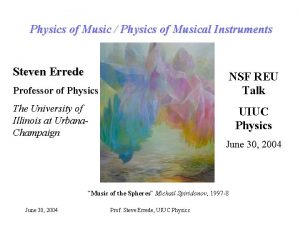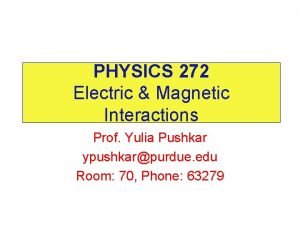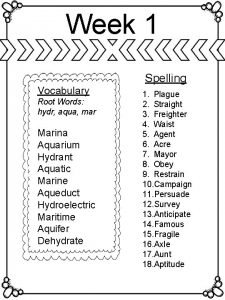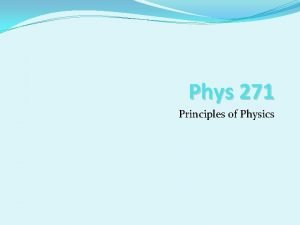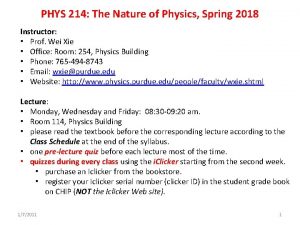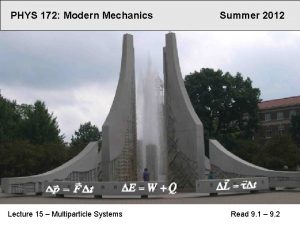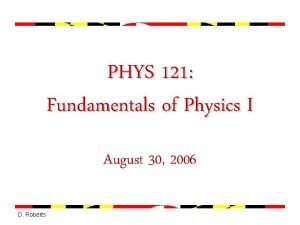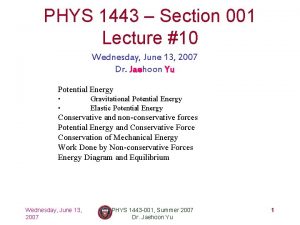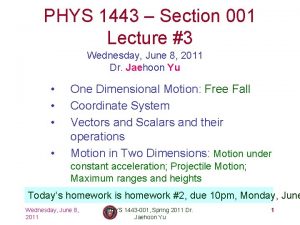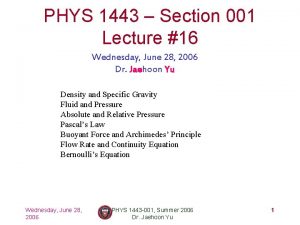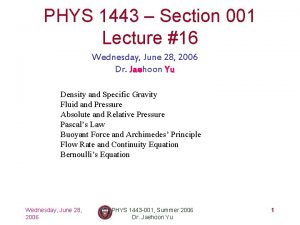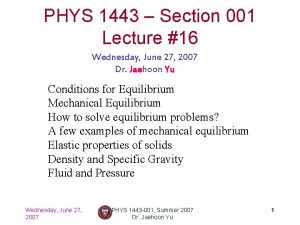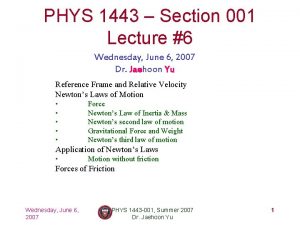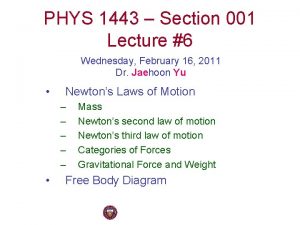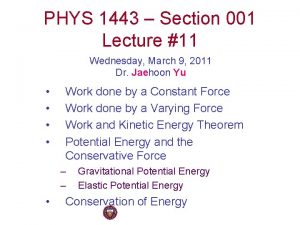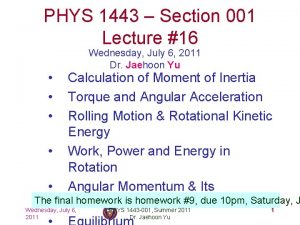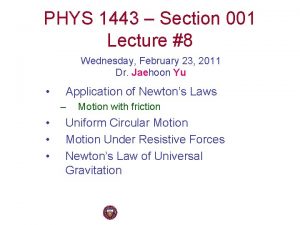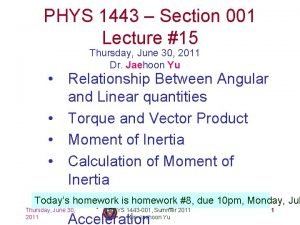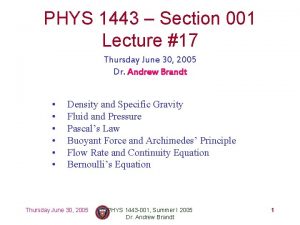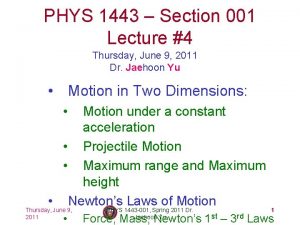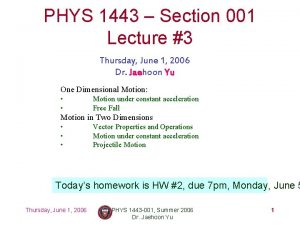PHYS 1443 Section 001 Lecture 6 Wednesday June

















- Slides: 17

PHYS 1443 – Section 001 Lecture #6 Wednesday, June 7, 2006 Dr. Jaehoon Yu Application of Newton’s Laws • Motion without friction Forces of Friction Uniform and Non-uniform Circular Motions Resistive Forces and Terminal Velocity Newton’s Law of Universal Gravitation Kepler’s Laws Wednesday, June 7, 2006 PHYS 1443 -001, Summer 2006 Dr. Jaehoon Yu 1

Announcements • Quiz tomorrow, Thursday, June 8 – At the beginning of the class – CH 1 – what we cover today (CH 6 – 4 or 5? ) • Reading assignments: – CH 4 – 7, 5 – 4, 5 – 5 • Mid-term exam – 8: 00 – 10 am, Thursday, June 15, in class – CH 1 – 8 or 9? Wednesday, June 7, 2006 PHYS 1443 -001, Summer 2006 2

Example w/o Friction A crate of mass M is placed on a frictionless inclined plane of angle q. ya) Determine the acceleration of the crate after it is released. y M y n q n Free-body Diagram q Fg a x xd x F= -Mg Supposed the crate was released at the top of the incline, and the length of the incline is d. How long does it take for the crate to reach the bottom and what is its speed at the bottom? Wednesday, June 7, 2006 PHYS 1443 -001, Summer 2006 3

Forces of Friction Resistive force exerted on a moving object due to viscosity or other types frictional property of the medium in or surface on which the object moves. These forces are either proportional to the velocity or the normal force. The resistive force exerted on the object Force of static until just before the beginning of its friction, fs: movement Empiric al Formul a What does this Frictional force increases formula tell till it reaches the limit!! you? Beyond the limit, the object moves, and there is NO MORE static friction but kinetic friction takes it over. Force of kinetic friction, The fk resistive force exerted on the object during its movement Opposite to the motion Which direction does kinetic friction apply? Wednesday, June 7, 2006 PHYS 1443 -001, Summer 2006 4

Example w/ Friction q Suppose a block is placed on a rough surface inclined relative to the horizontal. The inclination angle is increased till the block starts to move. Show that by measuring this critical angle, qc, one can y determine coefficient of static friction, ms. y n M a n Free-body fs=mkn Diagram x x Fg q F= -Mg Net force x comp. y comp. Wednesday, June 7, 2006 PHYS 1443 -001, Summer 2006 5

Newton’s Second Law & Uniform Circular Motion The centripetal acceleration is always perpendicular to velocity vector, v, for uniform circular motion. Are there forces in this motion? If so, what do do? The force that causesthey the centripetal acceleration acts toward the center of the circular path and causes the change in the direction of the velocity vector. This is called the happen centripetal force. Whatforce do you think will to the ball if the string that holds the ball breaks? Based on Newton’s 1 st law, since the external force no longer exist. Therefore, the ball will continue its motion without change and will fly away following the tangential direction the circle. PHYS 1443 -001, Summer Wednesday, to June 7, 2006 6

Example of Uniform Circular Motion A ball of mass 0. 500 kg is attached to the end of a 1. 50 m long cord. The ball is moving in a horizontal circle. If the string can withstand maximum tension of 50. 0 N, what is the maximum speed the ball can attain before the cord breaks? Centripetal Fr m acceleratio n: When does the string break? when the centripetal force is greater than the sustainable tension. Calculate the tension of the cord when speed of the ball is 5. 00 m/s. Wednesday, June 7, 2006 PHYS 1443 -001, Summer 2006 7

Example of Banked Highway (a) For a car traveling with speed v around a curve of radius r, determine a formula for the angle at which a road should be banked so that no friction is required to keep the car from skidding. x comp. y x y comp. (b) What is this angle for an expressway off-ramp curve of radius 50 m at a design speed of 50 km/h? Wednesday, June 7, 2006 PHYS 1443 -001, Summer 2006 8

Forces in Non-uniform Circular Motion Fr F The object has both tangential and radial accelerations. What does this statement mean? The object is moving under both tangential and radial forces. Ft These forces cause not only the velocity but also the speed of the ball to change. The object undergoes a curved motion under the absence of constraints, such as a string. What is the magnitude of the net acceleration? Wednesday, June 7, 2006 PHYS 1443 -001, Summer 9 2006

Example for Non-Uniform Circular Motion A ball of mass m is attached to the end of a cord of length R. The ball is moving in a vertical circle. Determine the tension of the cord at any instant when the speed of the ball is v and the cord makes an angle q with vertical. What are the forces involved in this m motion? • The gravitational force Fg T q • The radial force, T, providing Fg=mg R tension. tangentia l comp. Radial comp. At what angles the tension becomes maximum and minimum. What are the tensions? Wednesday, June 7, 2006 PHYS 1443 -001, Summer 2006 10

Motion in Resistive Forces Medium can exert resistive forces on an object moving through it due to viscosity or other types frictional properties of the medium. Some Air resistance, viscous force of examples? liquid, etc These forces are exerted on moving objects in opposite direction of the movement. These forces are proportional to such factors as speed. They almost always increase with increasing speed. Two different cases of proportionality: 1. Forces linearly proportional to speed: Slowly moving or very small objects 2. Forces proportional to square of speed: Large objects w/ Wednesday, June 7, 2006 Summer reasonable speed. PHYS 1443 -001, 2006 11

Resistive Force Proportional to Speed Since the resistive force is proportional to speed, we can write R=bv. Let’s consider that a ball of mass m is falling R v m through a liquid. In other words mg The above equation also tells us that as time goes on What does this mean? the speed increases and the acceleration decreases, eventually reaching 0. An object moving in a viscous medium will obtain speed to a certain speed (terminal speed) and then maintain the same speed without any more acceleration. What is the terminal speed in above case? The time needed to reach 63. 2% of the terminal speed is defined as the time constant, t=m/b. How do the speed and acceleration depend on time? Wednesday, June 7, 2006 PHYS 1443 -001, Summer 2006 12

Newton’s Law of Universal Gravitation People have been very curious about stars in the sky, making observations for a long time. But the data people collected have not been explained until Newton has discovered the law of gravitation. Every particle in the Universe attracts every other particle with a force that is directly proportional to the product of their masses and inversely proportional to the square of the distance between them. How would you write this law mathematically? G is the universal gravitational constant, and its value is With G Unit ? This constant is not given by theory but must be measured by experiments. This form of forces is known as the inverse-square law, because the magnitude of the force is inversely proportional to the square of the distances between the objects. Wednesday, June 7, 2006 PHYS 1443 -001, Summer 2006 13

More on Law of Universal Gravitation Consider two particles exerting gravitational forces to each other. m 2 r m 1 F 11 Two objects exert gravitational force on each other following Newton’s 3 rd law. F 21 Taking as the unit vector, we can write the force m 2 experiences as What do you think It means that the force exerted on the negative sign particle 2 by particle 1 is an attractive force, means? force is a field pulling toward #1. Gravitational force: #2 Forces act on object without physical contact between the objects at all times, independent of medium between them. What do you think the The gravitational force exerted by a finite size, gravitational force on spherically symmetric mass distribution on an the surface of the object outside of it is the same as when the entire mass of the distributions is concentrated earth looks? at the center of the object. Wednesday, June 7, 2006 PHYS 1443 -001, Summer 2006 14

Example for Gravitation Using the fact that g=9. 80 m/s 2 at the Earth’s surface, find the average density of the Earth. Since the gravitational acceleration is Solving for ME Therefore the density of the Earth is Wednesday, June 7, 2006 PHYS 1443 -001, Summer 2006 15

Free Fall Acceleration & Gravitational Force Weight of an object with mass m is mg. Using the force exerting on a particle of mass m on the surface of the Earth, one can obtain What would the gravitational acceleration be if the object is at an altitude h above the surface of the Earth? Distance from the center of the Earth to the object at the altitude h. What do these tell us about the gravitational acceleration? • The gravitational acceleration is independent of the mass of the object • The gravitational acceleration decreases as the altitude increases • If the distance from the surface of the Earth gets infinitely large, the weight of the object approaches 0. Wednesday, June 7, 2006 PHYS 1443 -001, Summer 2006 16

Example for Gravitational Force The international space station is designed to operate at an altitude of 350 km. When completed, it will have a weight (measured on the surface of the Earth) of 4. 22 x 106 N. What is its weight when in its orbit? The total weight of the station on the surface of the Earth is ME Since the orbit is at 350 km above the surface of the Earth, the gravitational force at that height is Therefore the weight in the orbit is Wednesday, June 7, 2006 PHYS 1443 -001, Summer 2006 17
 Purdue physics 241
Purdue physics 241 01:640:244 lecture notes - lecture 15: plat, idah, farad
01:640:244 lecture notes - lecture 15: plat, idah, farad Uiuc physics 102
Uiuc physics 102 Taekjip
Taekjip Physics courses ucsd
Physics courses ucsd Percent difference
Percent difference Phys 172
Phys 172 Http //www.phys.hawaii.edu/ teb/optics/java/slitdiffr/
Http //www.phys.hawaii.edu/ teb/optics/java/slitdiffr/ Http //vsg.quasihome.com
Http //vsg.quasihome.com Phys 212 equation sheet
Phys 212 equation sheet Phys 398 uiuc
Phys 398 uiuc Coulombs units
Coulombs units Define ostealgia
Define ostealgia 1 to 25 spelling
1 to 25 spelling Phys 271
Phys 271 Phys 214
Phys 214 Particl clicker
Particl clicker Phys 121 umd
Phys 121 umd



